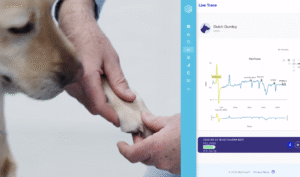Transform the way you assess pain — objective, reliable, repeatable.
Transform the way you assess pain — objective, reliable, repeatable.
How do we turn PainTrace® data into meaningful insights?
PainTrace® is an objective neurobiosignature correlated with human self-reported pain
PainTrace differentiates acute and chronic pain, measuring both magnitude and duration of the pain experience.
Quantify the individual experience of pain with an objective outcome measure to ensure treatment efficacy
The PainTrace® Pain Scale

Baseline Value
The PainTrace Baseline measures chronic pain - positive values indicate degree of non-painful state and increasing negative values indicate mild, moderate, and severe chronic pain state.
Pain Peaks
The PainTrace Acute Peaks quantify acute pain in response to in response to applied stimuli such as examination, movement, or touch. Peak amplitudes are highlighted by intensity.
How do we turn PainTrace® data into meaningful insights?
The PainTrace® Pain Scale
PainTrace® is an objective neurobiosignature correlated with human self-reported pain
PainTrace differentiates acute and chronic pain, measuring both magnitude and duration of the pain experience.
Quantify the individual experience of pain with an objective outcome measure to ensure treatment efficacy
![]()
![]()
![]()
![]()


Interpreting the PainTrace Pain Scale
Baseline Value
The PainTrace Baseline measures chronic pain - positive values indicate degree of non-painful state and increasing negative values indicate mild, moderate, and severe chronic pain state.
Pain Peaks
The PainTrace Acute Peaks quantify acute pain in response to in response to applied stimuli such as examination, movement, or touch. Peak amplitudes are highlighted by intensity.
Mild Acute Pain
Moderate Acute Pain
Severe Acute Pain
Case Examples
[Real-Time PainTrace] measures chronic pain and locates acute pain

In an orthopedic examination PainTrace detected and located a severely painful right shoulder and mildly painful left shoulder. The examination was followed by an x-ray which led to diagnosis confirming bilateral shoulder arthritis.
[Real-Time PainTrace] measures chronic pain and locates acute pain
In an orthopedic examination PainTrace detected and located a severely painful right shoulder and mildly painful left shoulder. The examination was followed by an x-ray which led to diagnosis confirming bilateral shoulder arthritis.

PainTrace tracks pain providing an indication of treatment efficacy

Osteoarthritis: Pre- and Post-Treatment
PainTrace identified the presence of acute and chronic pain and quantified treatment efficacy pre and post administering treatment
PainTrace tracks pain providing an indication of treatment efficacy

Osteoarthritis: Pre- and Post-Treatment
PainTrace identified the presence of acute and chronic pain and quantified treatment efficacy pre and post administering treatment
When to apply PainTrace
Trace 1
The initial trace is used to establish baseline pain levels prior to treatment or surgery, screen for painful conditions, or pinpoint the source of pain to guide diagnostics
Trace 2
The second trace can be used to evaluate rehabilitation or treatment efficacy, follow surgery procedures to assess the anesthetic protocol, and provide individualized treatment by refining initial treatment modalities to suit each patient
Trace 3
The third trace can be used to can be used to continually monitor the efficacy of treatment and enhance communication with pet owners, ensuring the patient is pain-free at each annual wellness visit
PainTrace Application
Step 1
Prepare the skin and apply sensors

- Shave all fur from the species-specific location
- Clean thoroughly with isopropanol
- Place sensors on completely shaven, clean, and dry skin
- Use SkinTac™ to better adhere sensors to the skin, if necessary
- Attach the PainTrace device and start a trace
Step 2
Perform an orthopedic exam

- Perform an orthopedic exam while annotating to give context to the PainTrace graph
- Annotate using speech to text or tap to text on the PainTrace app
- Begin by annotating the anatomy then palpate and manipulate the area you wish to examine
Step 3
Pin-point painful anatomy during the orthopedic exam

- Use the PainTrace graph and the context provided by the annotations to visualize which areas are painful
Step 4
Perform an activity

- Evaluate pain during activities such as walk, trot, and sit to stand while collecting PainTrace data
- In post-treatment visits, the activity can be used as a quick way to evaluate treatment efficacy in reducing pain
Step 5
Monitor response to treatment modalities

- PainTrace provides an individual response to treatment modality
- The PainTrace data can help determine the best utilization of the rehabilitation techniques and refine techniques to improve outcomes and reduce discomfort
Step 6
Analyze PainTrace data and compare with previous visit(s)

- Analyze your PainTrace data after the visit to determine chronic PainTrace baseline data and acute PainTrace peak deltas
- Use overlay reporting after two or more visits to evaluate treatment efficacy in reducing acute and chronic pain
Step 7
Communicate progress with pet owner

- Communicate patient pain with the pet owner by using acute PainTrace peak deltas and chronic PainTrace baselines to communicate the need for treatments
- Visualize improvement by using overlay reporting to depict mitigation of chronic and acute pain overtime
- Assure pet owners that treatments are efficacious or adjust rehabilitation if you and the pet owner are not seeing the desired improvements
- Accurately determine frequency and duration of ongoing rehabilitation where applicable
“PainTrace is a game changer that aids towards evaluating the location of pain, severity of pain, and treatment efficacy. PainTrace is an excellent device to assist with communicating patient pain to owners. In a fast-paced work environment, PainTrace helps me, as a busy clinician, to slow down and thoroughly evaluate every joint during my orthopedic exams to ensure I detect even the most subtle lameness.”
- Dr. Megan Kelley, DVM, CVA (IVAS), CVSMT, FCoAC